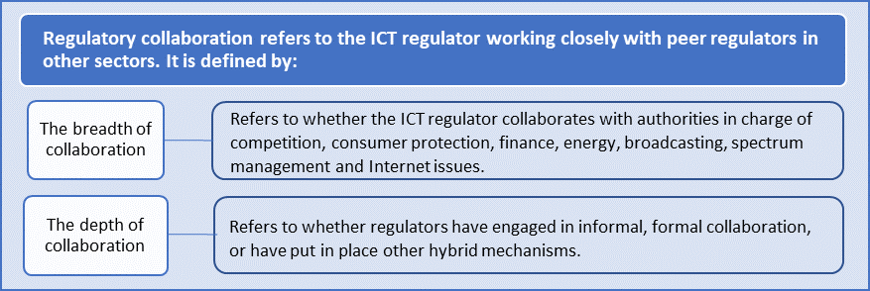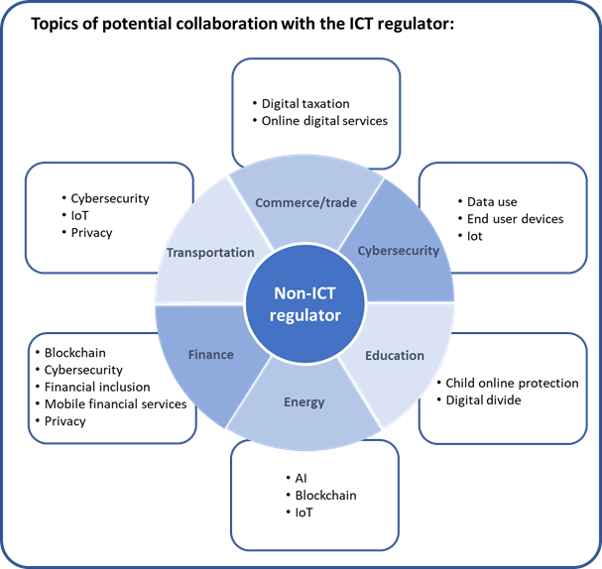Collaborative approaches to policy implementation for digital transformation
01.09.2020Introduction to institutional collaboration
Digital transformation is increasingly supporting all sectors of the economy, changing societies and market landscapes while improving access to and delivery of services across multiple industries. This revolution brings both challenges and opportunities, which will require greater collaboration between policy-makers, regulatory authorities, and other stakeholders to effectively harness technological progress and successfully address the challenges of digitalization. The International Telecommunication Union (ITU) has identified how collaborative regulation marks a fundamental change in the way that governments develop regulatory frameworks and rules. It reveals how collaboration among institutions, industry stakeholders, and cross-sector regulators is critical for regulatory relevance, coherence, and impact at the domestic, regional, and international levels in areas such as health, finance, education, transportation, and energy (ITU 2018).
ITU definition of regulatory collaboration

Source: ITU 2018: 129.
Today’s complex interconnected environment poses major challenges to regulators and policy-makers, revealing the need for more innovative and inclusive solutions to shape a common digital future and attain the United Nations Sustainable Development Goals (SDGs). Accordingly, in May 2016, at the Global Symposium for Regulators (GSR-16), the ITU presented the concept of collaborative, or fifth generation (G5), regulation under the generations of regulation model (see figure below). The G5 model adopts a new system of cross-sectoral regulation, involving harmonized rules with holistic and collaborative approaches, as well as high-level principles that will drive broader development and benefits for all digital service users worldwide (ITU 2020).
Generations of regulation model

Source: Maddens 2016: 16.
Optimal design of digital policies and regulation is crucial to accelerate digital transformation. The pace of digital transformation demands a new regulatory strategy that involves all stakeholders, of different sizes, backgrounds, and industries, as well as a market-driven and metric-based approach in which decisions and rules are based on detailed evidence. The combination of collaboration and informed decisions, together with social and economic impact considerations, are conducive to fast-forward digital transformation for all.
Since 2016, the ITU has tested its collaborative regulation approach, tracking the evolution of regulatory trends and policies in multiple countries. The “regulation generations” model has guided the ITU’s method of analysing the maturity of regulatory frameworks, producing the ITU’s Benchmark of G5 Collaborative Regulations (G5 Benchmark). Based on data from over 80 countries, most of which had already reached the G4 level, and using 25 individual indicators, the G5 Benchmark extends and complements the ITU’s ICT Regulatory Tracker, analyses regulatory trends, and presents how collaborative models can advance the UN SDGs.
In terms of global trends, the G5 Benchmark reveals that while the digital economy has gained greater traction, too few countries have reached the G5 maturity necessary to promote development and digital transformation. For instance, although the innovation accelerated by ICTs is disrupting and reshaping all sectors and markets, according to the G5 Benchmark, nine of 10 countries continue to regulate ICT as a separate sector of the economy. This can hamper fully realizing the benefits of digital transformation, for instance, by implementing cross-sectoral collaboration, harmonized rules, or new high-level policy design principles. Nevertheless, 8 per cent of countries have adapted their frameworks by implementing holistic and forward-looking regulatory approaches in order to harness the benefits of going digital across multiple economic sectors. Currently, Europe contains 10 of the 16 global G5 leading countries. Particularly, in terms of collaborative regulation, after examining more than 80 economies worldwide, the ITU identified Botswana, Norway, Singapore, and the United Kingdom as the G5 champions, representing Africa, Asia-Pacific, and Europe. These top ranked countries were assessed in terms of the degree of their collaboration between the ICT regulator and other authorities, as well as their policy and regulatory tools (ITU 2020).
Collaborative approaches to policy implementation for digital transformation
As previously noted, the G5 regulatory approach involves a new regulatory process in which stakeholders play a key role, and where the synergies across institutions provide greater capacity for and impacts on reaching common regulatory goals (ITU 2018).
To address the complexity of today’s digital environment, informal, semi-formal, and formalized collaboration is occurring across sectors. Informal collaboration is motivated by pragmatism, common interests, and capacity building, leading regulators to cooperate with each other outside of institutional frameworks. Formal collaboration “…involves systematic efforts to collaborate and define terms of engagement…” such as through memorandums of understanding (MoUs) or legislative means (ITU 2018). Semi-formal collaboration includes elements of both formal and informal collaboration and is perceived as an evolution of informal agreements.
Collaborative regulation builds on formalized processes to put a new emphasis on sector or multisector government regulatory agencies for competition, consumer protection, and data protection, among other sectors. As ICTs permeate all sectors and industries, a multisectoral regulatory approach is needed to effectively address the impacts and promote the progress of digitalization.
Competition
The liberalization of the ICT/telecommunication markets led to collaboration between the new telecommunication authorities and competition regulators. During the initial generations of regulation, ICT or telecommunication regulators were granted authority to set and enforce rules deemed necessary to protect competition and consumers. Their responsibilities typically included activities related to spectrum and number allocation, standard setting, and type approval, often also covering economic and social telecommunication-oriented regulation (e.g. interconnection, price regulation, universal service, licensing, and consumer complaints). In contrast, the jurisdiction of competition regulators generally included tasks related to anticompetitive behaviour, market dominance, pricing policies, and mergers, among others.
As a result, cooperation between competition and ICT authorities has developed as a common tool in digital service regulation. Today, a great number of countries have collaboration mechanisms to address overlapping areas of jurisdiction between the ICT and competition authorities, particularly related to pricing regulation, market power, and mergers. For instance, where both competition and ICT regulators exist, 60 per cent of countries use coordination arrangements, with a third of them being informal (ITU 2018). Countries where informal or semi-formal coordination arrangements are present include Brazil, Burkina Faso, Chile, Greece, Israel, Kuwait, Mali, New Zealand, Poland, and the United States. Formal collaboration mechanisms are implemented in countries such as Armenia, Bulgaria, Costa Rica, Egypt, Hungary, Jordan, Kenya, Norway, Papua New Guinea, and South Africa. Additionally, countries with joint programmes or committees include Australia, Malaysia, Tanzania, and Venezuela.
Consumer protection
Along with competition rules, many countries have enacted consumer protection provisions in telecommunication frameworks, including quality of service, number portability, universal service, and interoperability standards. Additionally, most countries also have general consumer protection laws to prevent consumers from being subject to unfair or deceptive trade practices, which may extend to ICT and telecommunication services.
The transition to digital markets has transformed the consumer protection regime into a more evolved and sophisticated framework, beyond consumer information and pricing rules, to address more complex matters such as net neutrality, data privacy, e-commerce, e-banking, and cybersecurity. Accordingly, the interaction of multiple consumer protection frameworks emphasizes the need to rely on collaborative arrangements between consumer protection authorities and sector-specific regulators. For example, as of 2018, two-thirds of existing ICT and consumer protection regulators have implemented collaboration mechanisms to address digital consumer matters, and more than half of these countries use informal collaboration, including Croatia, the Dominican Republic, Egypt, Iran, and Moldova. Countries such as Armenia, Jamaica, Norway, and Thailand have implemented formal agreements via MoUs (ITU 2018).
Data protection
The collection, processing, and transfer of information is a major component of the digital economy. ICT advancement has allowed the transmission of personal data on a global scale, where the Internet has simplified collecting and sharing information. As a result, many countries have issued data protection laws to restrict the way personal data may be collected and processed to safeguard individuals’ privacy rights. Today, 132 out of 194 countries have adopted legislation to protect personal data and privacy. Often, data protection rules are not incorporated into a single body of law, but are instead addressed on a sector-specific basis in multiple laws and regulations, according to the type of information afforded with such protection. That is often the case for health information or financial data, for example. Increasingly, countries are adopting comprehensive data protection laws, such as the EU General Data Protection Regulation (GDPR), that regulate how private and public sector entities may collect and process personal information across all sectors. These comprehensive data protection laws often establish separate data protection authorities (DPAs) to oversee and enforce the rules.
In contrast to long-standing collaboration arrangements that ICT regulators have with competition and consumer protection agencies, ICT authorities have so far been less likely to engage in collaborative efforts with DPAs. As of 2018, of the 72 countries reporting to the ITU that an ICT regulator and DPA exist, only 33 have implemented collaboration arrangements between the agencies. Of those, 85 per cent are informal agreements, such as in Armenia, Canada, Gabon, and Pakistan. Additionally, collaboration practices vary by region. For instance, Europe is the only region where formal collaboration occurs, while in Africa, Asia-Pacific, and the Americas, informal collaborative mechanisms are more common (ITU 2018). However, DPAs are fairly recent developments compared to competition and consumer protection authorities, so this continues to be an area where greater cooperation may evolve.
Other sectors
The influence of ICTs throughout the economy makes collaborative practices highly relevant in order to effectively address the impacts and promote the progress of the digital ecosystem. Accordingly, policy-makers and regulatory authorities should contribute to reducing jurisdictional conflicts and regulatory overlap across the digital economy and strengthen government capacity by securing leadership, political commitment, and strategies that lead to digital transformation (Digital Cooperation 2019). Additionally, roles and responsibilities should be made clear to all parties involved in the digital transformation process, as to establish appropriate mechanisms for collaboration and engagement between ICT regulators and other regulators (OECD 2017).
Example of points of collaboration between ICT regulators and other authorities

Source: TMG 2020.
Self-regulation and coregulation
Self-regulatory and industry/regulator collaboration are other mechanisms to provide flexible frameworks that help avoid burdensome regulation that could risk stifling innovation. Digital transformation emphasizes the need for innovative regulatory approaches based on trust and encourages stakeholders to assume responsibility within their own sectors, outside of government supervision and control. This results in high levels of cooperation between industry and regulators.
These inclusive mechanisms do not necessarily involve deregulation, understood as the elimination of any disproportionate or excessive regulation that would hamper market competition. Self-regulatory and coregulatory approaches can be implemented with legislation that establishes proper boundaries and obligations, with the regulator maintaining reserve powers. In line with this, regulators can engage in more light-handed regulation, encouraging voluntary compliance with industry policies or market-driven standards to minimize or avoid the need for more stringent regulatory intervention (ICT Regulation Toolkit). These more flexible regulatory approaches often involve an existing consultative body, comprised of industry representatives, government authorities, and other interested parties, which fosters inclusive dialogues with the ICT community and across the sector.
The outcomes of these inclusive regulatory processes generally involve the release of recommendations, guidelines, or codes of conduct on specific issues. In Australia, for example, the Australian Communications and Media Authority (ACMA) promotes industry self-regulation in several areas of the telecommunication, Internet, broadcasting, and radiocommunication sectors. According to the ACMA, industry codes are a key self-regulatory or co-regulatory mechanism in the Australian communications and media sectors (ACMA 2011).
References
ACMA (Australian Communications and Media Authority). 2011. Optimal Conditions for Effective Self- and Co-Regulatory Arrangements. Occasional Paper. https://www.acma.gov.au/sites/default/files/2019-08/Optimal%20conditions%20for%20self-%20and%20co-regulation%20Sep%202011%20pdf.pdf.
Digital Cooperation. 2019. The Age of Digital Interdependence. Report of the UN Secretary-General’s High-level Panel on Digital Cooperation. https://digitalcooperation.org.
ITU (International Telecommunication Union). 2018. Global ICT Regulatory Outlook 2018. Geneva: ITU. http://handle.itu.int/11.1002/pub/81234575-en.
ITU (International Telecommunication Union). 2020. Global ICT Regulation Outlook 2020. Geneva: ITU. https://www.itu.int/dms_pub/itu-d/opb/pref/D-PREF-BB.REG_OUT01 -2020-PDF-E.pdf.
Maddens, Sofie. 2016. Building Blocks for Smart Societies in a Connected World: A Regulatory Perspective on Fifth Generation Collaborative Regulation. GSR-16 Discussion Paper. Geneva: ITU. https://www.itu.int/en/ITU-D/Conferences/GSR/Documents/ITU _BuildingBlocksReg_GSR16.pdf.
OECD (Organisation for Economic Cooperation and Development). 2017. Digital Government Review of Norway: Boosting the Digital Transformation of the Public Sector. Paris: OECD. https://www.oecd-ilibrary.org/governance/digital-government-review-of-norway_9789264279742-en;jsessionid=vUaiIwDDPgCLyhTzFXCMSWEB.ip-10-240-5-132.
Last updated on: 19.01.2022